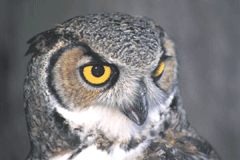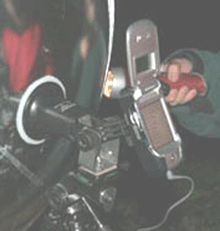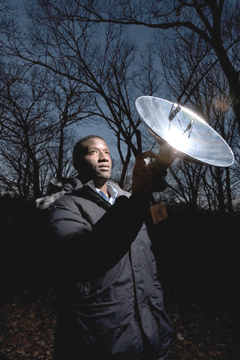Hoo’s Calling
Air Date: Week of June 29, 2007

MIT professor Dale Joachim tracks Great Horned Owls (Courtesy of U.S. Bureau of Reclamation)
Owls and other birds are just a phone call away, thanks to Dr. Dale Joachim. The MIT professor created a technology to monitor birds remotely via cellphones so that researchers can get a count of the animals without disturbing their habitats. IEEE Spectrums Willie D. Jones reports.
Transcript
CURWOOD: Some folks claim they can communicate with animals. And now, an electrical engineering professor at MIT is taking it one step further—he calls owls on his cell phone. Willie D. Jones of IEEE Spectrum went out into the field in Central Connecticut with this modern-day Dr. Doolittle to see if he had hit upon something worth hooting about.
[SOUNDS OF FOOTSTEPS]
JONES: On a cold, quiet night, a group of well-bundled souls trudges out to the end of a desolate dirt road. They stop between two stands of trees and quickly set up several tripods. Some are mounted with cell phones attached to loudspeakers, others have cell phones with receivers and recording equipment. MIT professor Dale Joachim heads this team. In the still of the night, he whispers the point of this excursion.
JOACHIM: To demonstrate that the owls respond to cell phone quality audio.
JONES: Joachim believes his innovation will help researchers and conservationists track and keep a fairly accurate count of animals—without repeatedly disturbing their habitats.

Cellphone device used to attract owls (Courtesy of Dale Joachim)
He taps the touch screen of his cell phone.
[SOUND OF TAPPING]
The handset controls a Web site housed in his office on the MIT campus. It lets him choose which of the loudspeakers will emit the series of whistles and chirps that faithfully replicate the birds’ calls. In this case, screech owls. He can also choose which receivers will listen for any responding bird-calls and record them. He uses multiple phones to get a better sense of the direction the sound is coming from.
JOACHIM: The idea is that in the future we can leave these things out in the forest and set them out with a little battery that will keep recharging the phone and keep it there for long periods of time.
JONES: And initiate contact with birds from anywhere in the world. Joachim hit upon the idea while talking to an ornithologist at the Audubon Zoo in New Orleans. The bird researcher described the preferred method of monitoring bird populations: sending a trained person to the critters’ habitat to actually count them. Joachim thought there had to be a better way.
JOACHIM: I suggested to her that we should probably automate this process. And the most interactive channel I could think about was the cell phone.
JONES: This automated tracking, he says, will allow humans to use birds and other animals as sensors.

MIT professor Dale Joachim tracks Great Horned Owls(Courtesy of U.S. Bureau of Reclamation)
JONES: Joachim himself could have used such a heads-up. When Hurricane Katrina struck southern Louisiana and Mississippi, he was at Tulane University, in New Orleans. In the aftermath of the storm, he and his graduate students scattered to schools across the United States, and the bulk of their work on the bird-monitoring project was destroyed.
JOACHIM: Certain species of birds and many animals left the New Orleans area before the hurricane came. And I think it’s worth looking into. In the sense that birds may have had advance warning, and hopefully they vocalized upon this warning. If we can learn something about the sort of sound, or the sort of changes in vocalization that happens when they have this sort of warning, we may be able to also have a second line of defense before something hits.

MIT Professor Dale Joachim (Photo: www.dalsimerphoto.com)
JONES: Suddenly, the field loudspeaker lets off its first chorus of pre-recorded owl calls.
[DIGITAL SCREECH OWL]
JONES: There we were at the moment of truth. Would any birds respond? I had my doubts. But then, there it was, softly in the distance:
[CALL AND RESPONSE]
JONES: A sustained period of call and response reminiscent of a soloist and a church congregation. The back-and-forth continued until another bird’s call caused one of the screech owls to clam up and take flight.
JOACHIM: They responded, but didn’t come close enough for us to take a picture or anything of the sort.
JONES: The MIT professor and his team, having made contact with birds at three woodland locations over the course of four hours, call it a night. During the next few months, they’ll refine the calling system in preparation for setting up a large bird-monitoring network. When Dale Joachim does finally get his equipment set up in forests around the world, it will give a new definition to the term “chat room.” For Living on Earth, I’m Willie D. Jones in Central Connecticut.
CURWOOD: That story comes to us courtesy of IEEE Spectrum magazine.
[“Eastern Screech-Owl” recorded by Lang Elliott for ‘A Guide To Night Sounds’ (Nature Sound Studio – 1992)]
Links
Living on Earth wants to hear from you!
Living on Earth
62 Calef Highway, Suite 212
Lee, NH 03861
Telephone: 617-287-4121
E-mail: comments@loe.org
Newsletter [Click here]
Donate to Living on Earth!
Living on Earth is an independent media program and relies entirely on contributions from listeners and institutions supporting public service. Please donate now to preserve an independent environmental voice.
NewsletterLiving on Earth offers a weekly delivery of the show's rundown to your mailbox. Sign up for our newsletter today!
 Sailors For The Sea: Be the change you want to sea.
Sailors For The Sea: Be the change you want to sea.
 The Grantham Foundation for the Protection of the Environment: Committed to protecting and improving the health of the global environment.
The Grantham Foundation for the Protection of the Environment: Committed to protecting and improving the health of the global environment.
 Contribute to Living on Earth and receive, as our gift to you, an archival print of one of Mark Seth Lender's extraordinary wildlife photographs. Follow the link to see Mark's current collection of photographs.
Contribute to Living on Earth and receive, as our gift to you, an archival print of one of Mark Seth Lender's extraordinary wildlife photographs. Follow the link to see Mark's current collection of photographs.
 Buy a signed copy of Mark Seth Lender's book Smeagull the Seagull & support Living on Earth
Buy a signed copy of Mark Seth Lender's book Smeagull the Seagull & support Living on Earth

